TAMPA – Life post-pandemic is much more expensive. It’s harder to find a doctor. Fewer children are ready for kindergarten. Third grade reading levels aren’t much better.
On the bright side, the air is easier to breathe. Commuters are spending less time in their cars, probably because of remote and hybrid schedules.
This is the state of work and life in the Tampa Bay area as told by two economic competitiveness reports released today by researchers from the Tampa Bay Partnership and the University of South Florida Muma College of Business.
Researchers shared some high notes — as well as some sobering trend lines — at the sixth State of the Region community luncheon held on USF’s Tampa campus.
The two data-driven reports gauge where the area stacks up against similar metropolitan communities. In their 2023 analysis, the main findings from the 2023 Tampa Bay E-Insights Report and 2023 Regional Competitiveness Report show:
- Tampa Bay is No. 1 in attracting new residents of all ages.
- Housing and transportation take up 54% of the average household budget in Tampa Bay.
- The search for remote jobs continues to be strong and increasing in all comparable communities.
- Around half of Tampa Bay area students are not at a third-grade reading level or prepared for kindergarten.
- Mental health indicators, such as depression prevalence rates and frequent mental distress, have been rising.
Close to 400 business leaders, community organizers and government officials attended the annual luncheon. For the past six years, USF and the Tampa Bay Partnership have teamed up to compile the two complementary benchmarking reports.
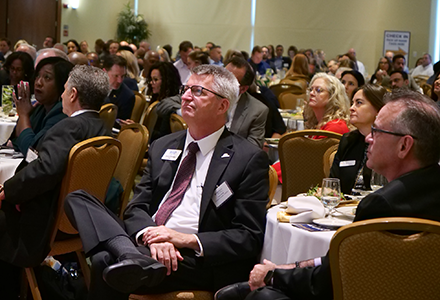
“The post-pandemic recovery continues, but our workplace practices have shifted,” said GJ de Vreede, interim dean at the USF Muma College of Business. “Our lifestyles are changing as a result. Looking at how Tampa Bay stacks up in terms of its economic opportunities as well as its quality of life will help us identify where we need to invest our time and resources so that everyone in the region thrives.”
The reports offer a glimpse into the region’s standing among 19 similar-sized peer and aspirational metropolitan areas. The publications also serve as a roadmap for local and state legislators, public and private business leaders, and academic stakeholders to improve the region’s economic health and growth.
Researchers with the USF Muma College of Business published the 2023 Tampa Bay E-Insights Report, a 56-page data-driven big-picture look at how the Tampa Bay area’s eight-county region compares in key economic metrics. The Tampa Bay Partnership, in collaboration with Community Foundation Tampa Bay and United Way Suncoast, produced the 2023 Regional Competitiveness Report.
“It is important to note that these are not data points that we will see significant changes in yearly increments, and that is why it is essential that we foster regional collaboration focused on long-term impact,” said Bemetra Simmons, president and CEO of Tampa Bay Partnership.
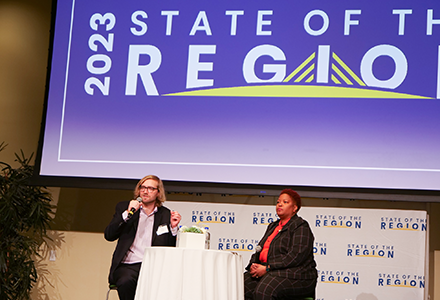
“State of the Region brings together many thought leaders who can use the research to set strategies, build relationships and align resources to achieve our goals,” she said.
Overall, the Tampa Bay region showed a year-over-year improvement in 36 of the 67 indicators in the partnership’s report.
During Friday’s 90-minute event, researchers took turns explaining the data and sharing motion charts to illustrate the trend lines. Industry business leaders also offered topical insights during “Fireside Chat” segments.
THE STATE OF WORK
On the state of work front, researchers revealed:
- Wages are not keeping up. The average wage in Tampa Bay is below the $68,000 national average. The region ranked No. 18 among the 19 comparison communities.
- The overall poverty and poverty among youth worsened.
- Median household net worth fell both in value and ranking.
“There is positive news from entrepreneurs and how they are supporting the economic well-being of the region,” said Lucia Farriss, the senior director of research, analytics, and public policy, at the Tampa Bay Partnership. “Our business establishment start rate is the fifth highest among comparison communities at 11.5%”
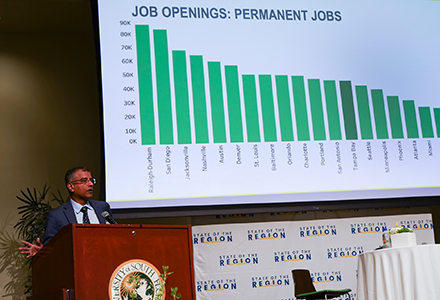
USF’s Balaji Padmanabhan, the director of the Center for Analytics and Creativity at the Muma College of Business, said real-time signals about job openings tell a story less about Tampa and more about something broader.
“The best job markets aren’t in the biggest cities,” he said. “Last year, the Wall Street Journal did a study on the best job markets and the top few we’re seeing are exactly the cities they identified. The data doesn’t tell us why, but we think that cost, overall business environment, and quality of living concerns are contributing to this trend.”
Padmanabhan offered a stunning data point: about 60 to 90% of all jobs listed are now marked as remote.
André Dua, a member of the McKinsey Global Institute Council, shared his thoughts on trends on the workforce and the future of work.
“Our view is that all work will change,” Dua said. “Seventy percent of all jobs could have more than 30% of their jobs automated.”
THE STATE OF LIFE
On the state of life, the traditional indicators showed:
- Housing and transportation easily consume over half of every dollar earned by Tampa Bay residents. The region saw a 26% increase in existing home sales prices, more than double the national average of 11%.
- The average commute time improved to 26.8 minutes, likely due to hybrid and remote work options.
- Kindergarten readiness declined, with less than half of young children entering school without the necessary skills. And third grade reading ability fell to more than half.
“Strong performance in kindergarten readiness and third-grade reading contributes to higher graduation rates, and less disconnected youth. Progress in these areas boost educational outcomes, which in turn shape prosperity as an adult,” Farriss said.
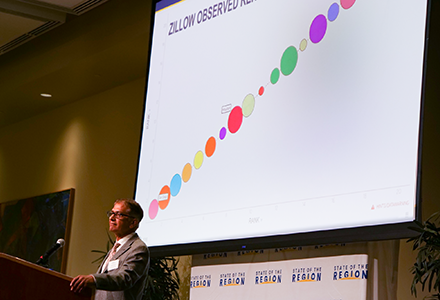
USF’s Shivendu Shivendu, an associate professor in the School of Information Systems and Management, took a deeper dive into the key trends in housing affordability using data from Zillow.com.
The data showed that the average rental value in the Tampa Bay region has increased over the years, while Tampa Bay’s competitive position dropped to No. 14.
“Housing affordability both in terms of rental and ownership has worsened for the Tampa Bay region over the last five years,” Shivendu said. “This has implications for our region’s attractiveness for talent as well as for new businesses. This may significantly impact the future of life in our region.”
A CALL TO ACTION
The reports and their findings have become trusted benchmarking tools used by local and state leaders to rally resources and combine forces. Leaders echoed the importance of coming together to take stock of shared challenges and to measure progress.
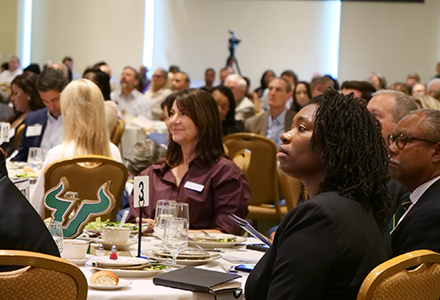
Brian Auld, president for the Tampa Bay Rays and Rowdies and current chair of the Tampa Bay Partnership, encouraged the ballroom filled with business and civic leaders to not shy away from the data.
“We must invest in transportation, education, and resiliency. We must address our housing and affordability crisis. We must provide support for the increasing challenges surrounding physical and mental health. All of us understand this,” Auld said.
He also challenged Tampa Bay leaders to work together for the community’s long-term success.
“It is hard work to move things forward. It is hard to put in the effort, to dedicate the resources, to fight the good fight, especially when the results may take years or decades to manifest,” he said. “But we know that it will benefit our community in the long run.”
